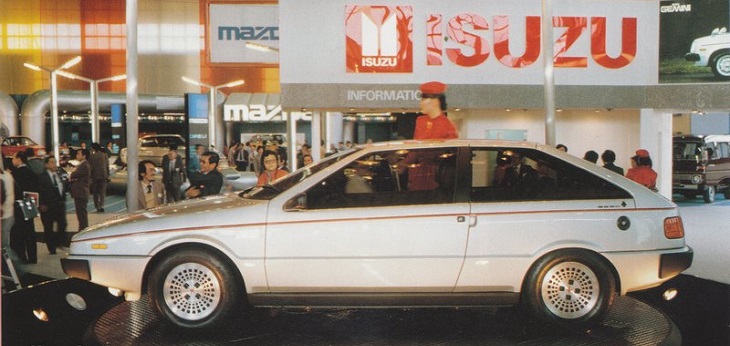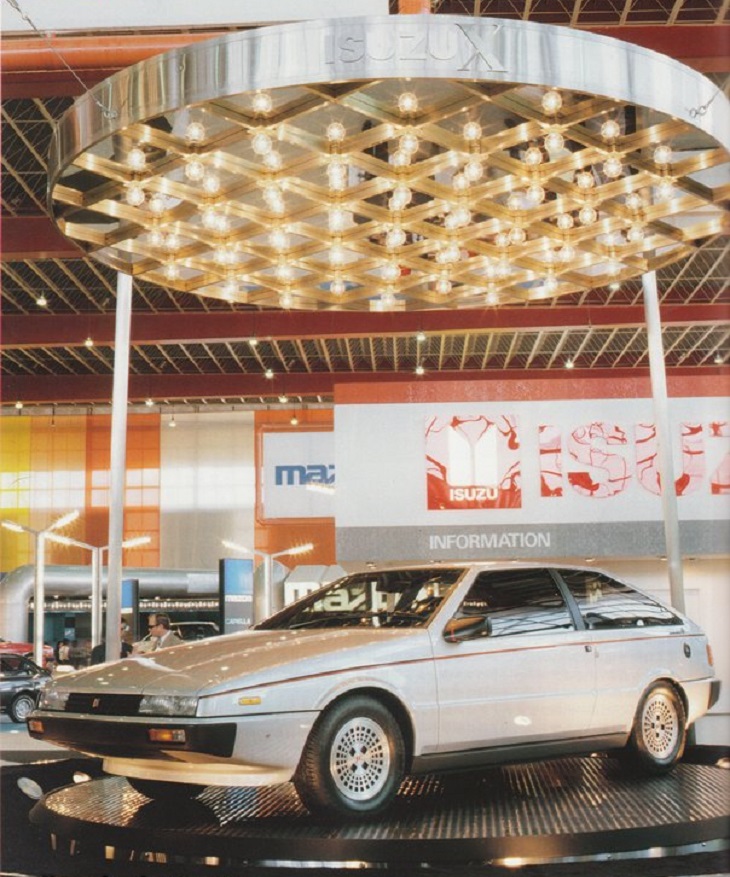A Brief History
A brief history of the car and concept (see Asso di Fiori for more about the design)
It was for the 1979 Motor Show that Giorgetto Giugiaro unleashed his talent by designing the “Asso di Fiori” or Ace of Clubs concept car that was to become the Isuzu Piazza. 24 months later at the 1981 Motor Show, the Isuzu stand attracted much attention by showcasing the first pre-production Piazza in all its glory.
Isuzu are Japan’s oldest car company, starting life in 1916 as the Tokyo Ishikawajima Shipbuilding and Engineering Co. Ltd., when they embarked on the manufacture of automobiles, effectively starting the revolutionary Japanese automotive industry.
Starting by producing commercial vehicles, among the first models were in fact Wolseley trucks made under license. In the early 1930s, a diesel research committee was established, leading to the production of the company’s first air-cooled diesel.
In 1939, the first truck bearing the “ISUZU” trademark rolled off the line, the first step in establishing one of the most widely respected and best selling truck manufacturers in the world.
Passenger cars were added to the Isuzu portfolio in 1953 as a result of an agreement between Isuzu and the Rootes Group, where again, they cut their teeth building British vehicles under license.
In 1961, production started at the Fujisawa plant with the Bellel, Japan’s first diesel powered commercial passenger vehicle. The introduction of the Bellett saloon in 1963 marked the real start of Isuzu’s very own car industry, with the 117 Coupé and Florian models introduced in 1966.
1971 saw an affiliation agreement between Isuzu and General Motors which brought about platform sharing, and joint development and marketing strategies, something which is now commonplace in the auto industry. The first passenger car to result from this collaboration was the Isuzu Gemini, part of the GM ‘T’ car concept which encompassed the Holden Gemini, Vauxhall Chevette and Chevrolet Chevette models, and would later provide the underpinnings for the Isuzu Piazza.
Isuzu Piazza started as a “dream car”, a motor show special. But Isuzu were so delighted by Giugiaro’s plan for a coupé which would seat 4 adults, they put it into production, seeing introduction in its home market in early 1982, making its way into America later on that year as the Isuzu Impulse.
Great Britain first caught a proper glimpse of the Piazza at the 1985 Motor Show, the result of a fledgling Isuzu Great Britain promoting their “Ace”. Based in Ashford, Kent, Isuzu GB’s initial import quota was 300 units, with initial interest boding well for the car’s, and the company’s, future. However it was not to be – after 11 months of trading, November 1986 saw the arrival of the official receivers. At this point, 535 cars which had arrived at Sheerness Docks were seized by the liquidators, where they remained until 1987 when Alan Day purchased them for £3.475m, which equates to £7000 per car. Some cars sold through Alan Day’s Mercedes dealership in Hampstead, while the rest found their way into market via selected Subaru dealers, resold at £9995.
All was however not lost. International Motors, UK concessionaires for Subaru, had spotted an opportunity and had sent staff to Japan to negotiate for franchise and liquidator stock, only to return to the UK and find that the deal with Alan Day had already been done. Undeterred, their role as the new official UK importer of Isuzu cars rose out of the collapse and International Motors worked to re-establish sales, with the re-engineered and subtly re-styled “Handling by Lotus” (HBL) Piazza. An agreement was struck whereby International Motors would honour any warranty claims from owners of “bankrupt stock” cars, with £50k worth of financial backing from Alan Day.
Sadly, Piazza sales were never what International Motors had envisaged. Heavily criticised by the motoring press in the early days for twitchy handling, cluttered controls and dated powertrain, even the vast improvements made by Lotus couldn’t secure a safe future for the Piazza in Britain. With less than 40 cars registered in the last year (1990), International Motors had long by then switched their attention to the fast-growing and lucrative 4×4 market and their contender, the Isuzu Trooper.
Breakdown of UK sales – official imports
| 1985-86 | ‘C’ reg | 214 |
| 1986-87 | ‘D’ reg | 803 |
| 1987-88 | ‘E’ reg | 478 |
| 1988-89 | ‘F’ reg | 129 |
| 1989-90 | ‘G’/’H’ reg | 38 |
Total = 1662 units – last car registered 01/11/90
The most disturbing fact is the rate of attrition suffered by this already tiny number of cars. The table below shows data obtained from the SMMT which relates to actual figures of cars remaining as “registered for road use – i.e. taxed!”.
| DATE | PRE | HBL | REMAINDER |
| DEC 96 | 871 | 431 | 1302 |
| DEC 97 | 761 | 418 | 1179 |
| DEC 98 | 637 | 391 | 1028 |
| DEC 99 | 508 | 348 | 856 |
| DEC 00 | 355 | 272 | 627 |
| DEC 01 | 240 | 210 | 450 |
| DEC 02 | 155 | 146 | 301 |
| DEC 03 | 123 | 103 | 226 |
| DEC 04 | 85 | 74 | 159 |
| DEC 05 | 59 | 52 | 111 |
| DEC 06 | 41 | 38 | 79 |
| DEC 07 | 26 | 34 | 60 |
| DEC 08 | 25 | 30 | 55 |
| DEC 09 | 26 | 34 | 60 |
| DEC 10 | 15 | 25 | 40 |
Please get in touch if you know of a Piazza festering away anywhere; IPTOC will always consider rescuing a car, even if it is only good for spare parts. See the ‘Contacts’ page for info on how to get in touch.





